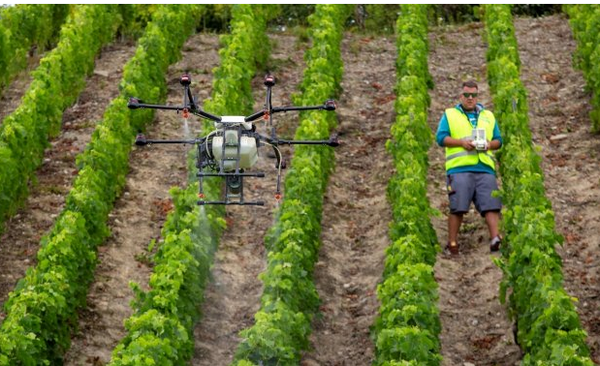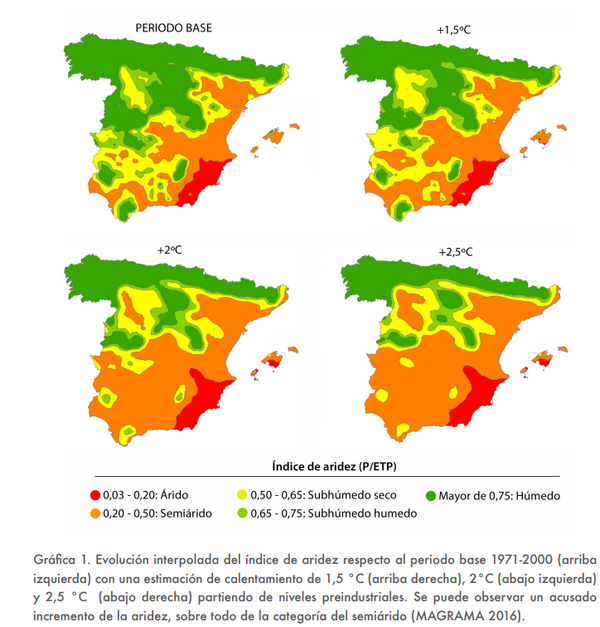Every year, 6% of the value of agricultural production in Spain is lost, more than 550 million euros. This is the result of the first major informative study, "The countdown is on. Impacts of climate change on Spanish agriculture," carried out by a farmers' organization.
Pablo Resco, from the farmers' organization COAG, presented the most relevant results of his years of research into the scientific literature on the effects of global warming on Spain's agriculture. Although regional differences may appear, no area is immune to global warming, so it was important to know to what extent the Spanish agricultural sector could be affected in different scenarios. For this reason, the author analyzed four agricultural systems of great relevance for Spain: olive groves, vineyards, cereals, and the dehesa*.
The three crops chosen for the study altogether occupy more than 50% of the cultivated area, are distributed over a large part of the national surface, are of great economic importance, and are linked to basic products of Spanish gastronomy and culture. The dehesa was also included for its high environmental value and its wealth of agroforestry resources, key for extensive livestock farming. Through the study, the aim was to see the potential cost of not making the necessary efforts to reduce emissions.
Agriculture and climate change in Spain
The agrifood sector is one of the driving forces of the Spanish economy, accounting for 5.8% of national GDP (11% if trade is included). It is one of the five sectors with the highest export volume and, with nearly €60 billion, represents 17% of total exported goods with a trade surplus of nearly 1% of GDP. But the sector depends on agricultural production that is threatened by climate change, and rising temperatures could trigger a series of effects with major consequences for the agricultural environment and the economy as a whole.

Climate change is one of the great challenges for agriculture and food, given that the consequences of rising temperatures could modify the fragile balance in which many crops are grown. This risk is greater in the Mediterranean countries, one of the regions most affected by global warming, and specifically in Spain, where 75% of its surface area is already at risk of desertification (Fig. 1).
 Fig. 1. Evolution of the aridity index with respect to the 1971-2000 base period from pre-industrial levels
Fig. 1. Evolution of the aridity index with respect to the 1971-2000 base period from pre-industrial levels
At present, agricultural insurance's claims ratio for extreme weather events can result in a loss of at least 6% of the value of agricultural production each year. Climate change would increase the intensity and frequency of these events. In addition, the decrease in vegetation cover due to rising temperatures and decreasing precipitation, combined with its concentration in the form of heavy rainfall, could increase soil erosion and further increase the risk of desertification.
- A warming of 1.5°C would result in a significant drop in yields and production quality in the current cultivation areas, but especially in the hotter and drier areas of the south of the peninsula.

- With an increase of 2°C, the damage could be very serious and, for example, endanger the holm oak dehesas in the westernmost part of Andalucía or Extremadura. Yields of cereals such as wheat could drop by more than 15% in some regions. The area of high-quality vineyards could be reduced by 20%. And in the case of olive trees, only the picual variety could maintain dryland yields in inland growing areas. However, from a warming of 2.5°C onwards, even the yield of this variety would suffer significantly without water supply. Moreover, holm oak dehesas could disappear in large parts of the southern half of the country.
- The greatest losses would be associated with increased water stress due to increased evapotranspiration, higher temperatures, and lower rainfall. This situation would be accompanied by a higher frequency of droughts, up to 5-10 times higher if they exceed 1.5-2°C. In addition, rainfall would be more intense, leading to erosion, and would be concentrated in periods such as autumn, making water less usable for agriculture.

- Damage could be further increased by the higher incidence of pests and diseases. In the case of wheat, with a 2°C increase, current losses could reach up to 60%.
- Although there are adaptation measures that could cushion some of the impact, they have a limited capacity that could be exceeded if there is no reduction in greenhouse gas emissions.
- An example is the water available in a country where 75% of the land area is at risk of desertification, and 25% of the aquifers are at risk. Water resources could decrease by 11% once 2°C of warming is reached, which would increase competition and conflict over the scarce resource.
Climate change and GDP
In the case of Spain, where in the last 30 years, major climate-related disasters alone have caused losses of €25 billion (half of which are drought-related), the damage could increase dramatically if emissions continue at the current rate. This scenario would lead to an increase of 2°C compared to pre-industrial periods in 2050, which could reduce national GDP by more than 7% compared to a scenario without climate change.
Even if the temperature were to rise by no more than 1.5°C, the losses would amount to 2.5% of GDP.
*The dehesa is a vast area of forested rangeland, covering about the size of Belgium. This special habitat covers much of southern and western Spain, across large parts of Andalucía and Extremadura, and reaching into Portugal. It is the usual rearing area of the Iberian pig.
Source: agroberichtenbuitenland.nl
